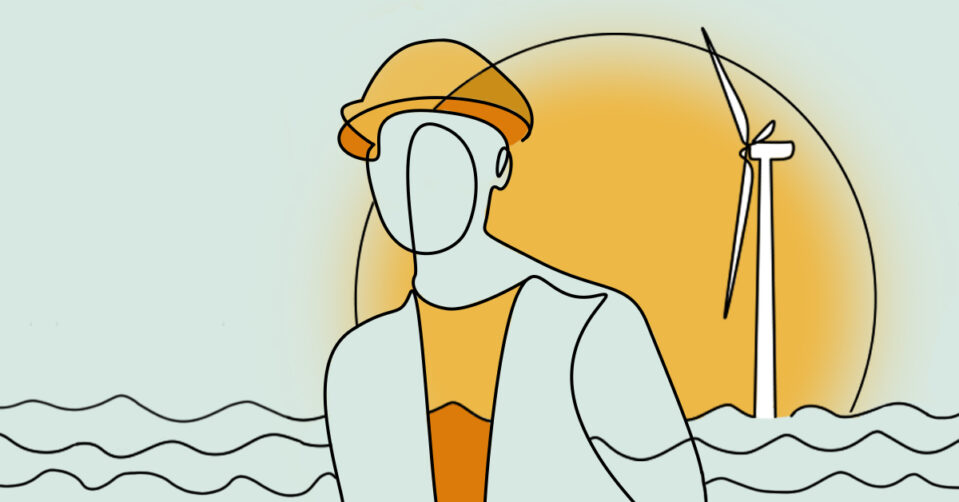Winds of Change: Developing a Domestic Supply Chain & Good Jobs in the Offshore Wind Sector
Mo-Yain Tham (NY Policy Manager, Jobs to Move America) / May 11, 2023

The buzz around the nascent offshore wind sector is palpable. An upcoming conference promoting “the U.S. offshore wind industry boom” describes an “unprecedented 1,000 GW of U.S. offshore wind resource” that “remains untapped, waiting to be unleashed!” The $70 billion capital investment that could generate business for the U.S. offshore wind supply chain also merits an exclamation mark.
Despite this anticipated investment, the U.S. lacks a domestic offshore wind (OSW) supply chain. Instead, companies must import components from Europe. The Department of Energy predicts that delays on the supply chain front could seriously affect project costs for U.S. developers, pushing them “above European market costs for large-scale commercial deployment.”
As the U.S. plays catch up, the U.S Department of Energy expects the domestic offshore wind industry to support 77,000 jobs. This impressive job growth, however, needs strong labor parameters in place to ensure that these jobs will be good jobs. Federal, state and local government agencies regulating and awarding contracts to developers can proactively ensure that any public funding for offshore wind projects comes along with strong labor provisions. This will help make sure that the “green energy transition” retains and creates good, community sustaining jobs.
For example, New York State can ensure its “nation-leading offshore wind goal of 9,000 megawatts” contributes to quality jobs in this industry. Through the State’s engagement with labor organizations, it has already taken a huge step with the inclusion of prevailing wage and Labor Peace Agreements in its purchasing process in order to ensure the construction of these projects are done with union labor.
In addition, as the New York State Energy Research and Development Authority (NYSERDA) developed its third competitive offshore wind solicitation, Jobs to Move America worked with NYSERDA to prioritize the creation of good jobs throughout the supply chain. NYSERDA requires developers and identified manufacturing suppliers to complete the NY Jobs and Workforce Plan. Developers must submit detailed offer forms accounting for the wages, benefits, training investments, and jobs in disadvantaged communities and with minority owned businesses. The goal is to encourage the bidders to “compete up” with their good jobs commitments, as well as to boost reinvestment or rehabilitation of existing New York ports and manufacturing facilities.
The NY Jobs Plan is part of the broader industrial policy to ensure government spending has enforceable specifics about job quality, training, and follow-through that can ensure workers and low-income communities are the ones benefiting from this developing industry.
As the International Union of Electrical Workers-Communications Workers of America (IUE-CWA) stressed during a recent visit to the White House, the union “is working actively” to bring offshore wind work “to its facilities and ensure that the taxpayer dollars being invested in this new industry are going towards developing a strong, unionized, domestic supply chain.”
Developers and manufacturers are already responding to the incentives to invest in New York’s offshore wind sector. GE announced plans to construct two new offshore wind manufacturing facilities in New York if it wins enough orders from developers bidding on NYSERDA’s third competitive bid solicitation. In addition, Vestas proposed a wind turbine blade manufacturing facility near Albany and Siemens Gamesa is going to build nacelles (the housing that contains a wind turbine’s rotor and generator) at the Port of Coeymans on the Hudson River in response to the same bid solicitation.
However, the stark reality is that a majority of employees working at future offshore wind manufacturing facilities in New York will likely live in the frontline communities that are most impacted by climate change and environmental injustices. Early community participation will be critical to ensuring that there is public accountability to these labor agreements and in-state facility commitments made by the developers. This can be accomplished through listening sessions with workers and affected communities and upholding the principles of a just transition.
At the regulatory level, state and local agencies must make participation accessible, prioritize listening to input from impacted community members, and adequately address concerns, so that impacted communities can enjoy the economic benefits of these offshore wind developments. Ultimately, this engagement also ensures that these community investments are transformative and long lasting, so communities are prepared and can anticipate the next shift in technology.
